Aarti significance, science, importance, symbolize, benefits, meaning (full info) | Why do we perform (do) Aarti
Namaste friends, how are you doing today? Welcome to #BhagavanBhakthi website / blog.
Bhagavan Lord Sri Vishnu (Krishna) (Rama) (Hari) (Narayana) (Trivikrama) (Narasimha) (Vedavyasa) and Goddess Lakshmi (Rukmini) (Sita) (Dharini) blessings to you and your family!
In this website / blog, you will always learn about #Hinduism #Sanskrit language.
Also subscribe to my YouTube channel from this link #BhagavanBhakthi to view videos about #Hinduism #Sanskrit language.
Just before going to “Aarti significance, science, importance, symbolize, benefits, meaning (full info) | Why do we perform (do) Aarti“, let us have some brief and very important information.
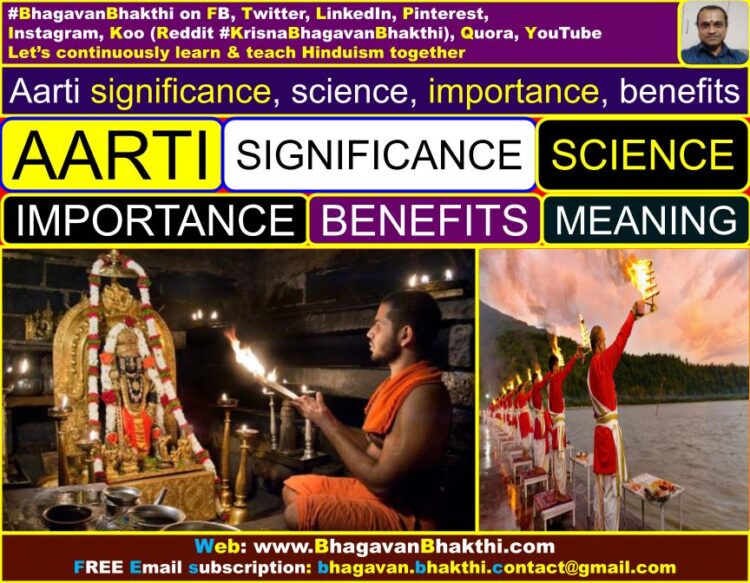
Some of the common or frequently asked questions (FAQs) about Aarti is as given below:
Why do we do aarti clockwise | How to do aarti of a person | How do you take Aarthi for someone? | What is the science behind aarti? | How to do aarti of god | How to do aarti of god using Deepa (Diya) (camphor) and others |
The word ‘Aarti’ or ‘arti’ (आरती) (āratī) is derived from the Sanskrit word आरात्रिक (Aratrika) (ārātrika), which means something that removes Ratri, that is, it eliminates darkness from our life (or light that is waved in front of God / Deity as Mahaneeraajana / महानीराजन / mahānīrājana).
Aarti or Aarti ritual is said to be derived from the Vedic concept of Yajna or Homa. Incense represents a purified state of mind and one’s “wisdom” is imparted through adherence to the rules of timing and order of offerings.
Thus, one’s entire existence and all aspects of physical creation are symbolically offered to Lord Sri Vishnu (Krishna) or other Gods through the ceremony of aarti (arti). The term may also refer to a traditional Hindu devotional song sung during a ritual.
Aarti (Arti) plate is usually made of metal, usually silver, bronze or copper. One or more cotton wicks (batti) (baati) (always an odd number) are dipped in tila (til) (sesame) oil or ghee and then lighted or camphor is burnt instead. The plate may also contain flowers, incense and akshata (rice).

[Note : Here incense means pure dhoopa (dhoop) and not the agarbatti (agarbathi) which are available in the market with or without packing. Try to find pure incense and use the same instead of the locally available agarbatti (agarbathi).]
What is the purpose of Aarti (Arti) : The purpose of performing aarti (arti) is to wave lighted wicks (batti) (baati) in front of the deities in a spirit of humility and gratitude, in which the faithful devotees and followers of Lord Sri Vishnu and other Gods immerse themselves in the divine form of God.
Aarti (Arti) symbolizes the five elements as given here : Akasha (Ether / Space), Vayu (Wind) (Air), Agni (Fire), Jala (Jal ) (Water) and Prithvi (Earth).
What is communal (group) Aarti (Arti) : Communal or group aarti is performed in divine places like temples (mandirs) (devalayas). However, devotees do it in their homes, when there are many people in the family or when there are many people present such as various family members, relatives, neighbors, friends etc.
Aarti (Arti) significance and importance : When Aarti (Arti) is performed, the performer faces the deity of Lord Sri Vishnu (Krishna) or other Gods (or a divine element such as the river Ganga) and focuses on the form of the deity looking into the eyes of the God (Eyes are said to be the windows between the atma / soul / humans and Paramatma / God).
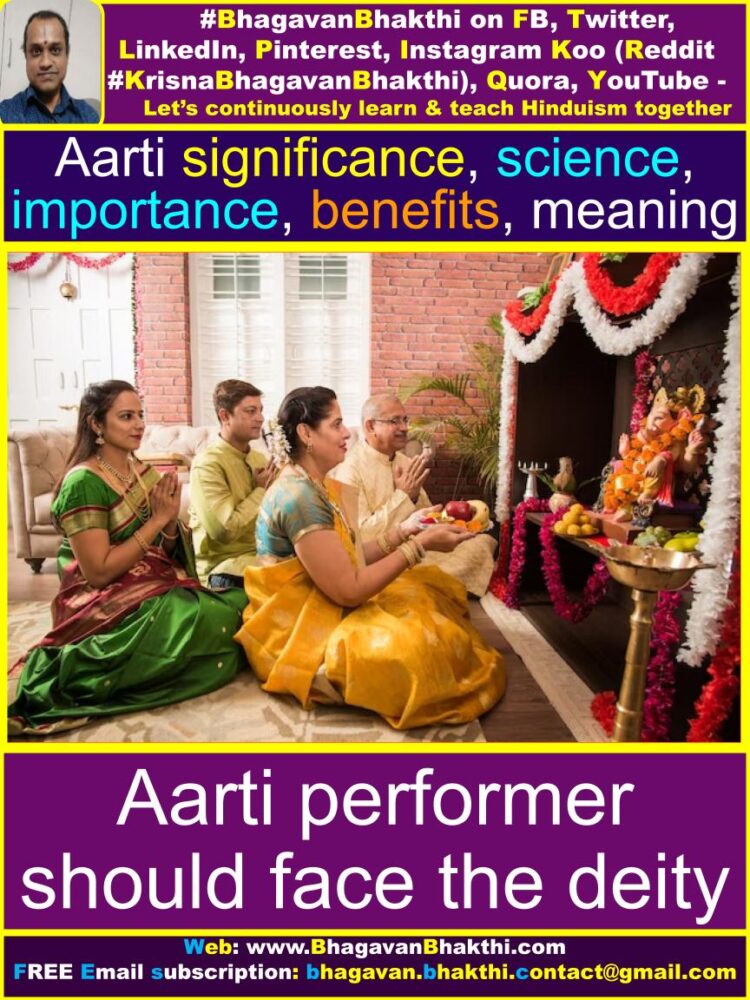
Why do we do Aarti (Arti) clockwise : Aarti (Arti) is waved (performed / done) only in a circular way, i.e. only in the clockwise direction. It is the same as doing Pradakshina (circumambulation) (parikrama) around God (Deity). God should be on our right side and this is the right way to do Aarti (Arti) of God (Deity).
Pradakshina in Sanskrit means to go around or rotate around the God in a clockwise direction. Pradakshina = Pra + Dakshina = Praying (Prarthana) + on our right side. Here, Dakshina in Sanskrit means on our right.
The idea here is that Aarti represents our daily activities, which revolve around God as the center of our lives. Seeing God while performing the aarti reminds the performer (and the participants in the aarti) to place God at the center of all activities and reinforces the understanding that everyday mundane activities are secondary in importance.
This understanding gives devotees and followers the strength to withstand unexpected grief and keeps them humble and God-remembering in moments of joy and sorrow. Aarti represents one’s soul apart from worldly activities – thus, Aarti signifies that one is external to the Supreme God.
Doing Aarti reduces one’s ego and pride, and helps one to remain humble in spite of high social and economic rank. A third common understanding of doing Aarti is that the aarti serves as a reminder to be vigilant so that the forces of material pleasures and desires do not overcome the individual.
Just as a lighted wick (baati) (batti) provides light and drives away darkness, so does one’s vigilance ward off the influence of the material world. Aarti is not limited to God alone. Aarti can be performed not only for all forms of life but also for inanimate objects which help in the progress of culture.
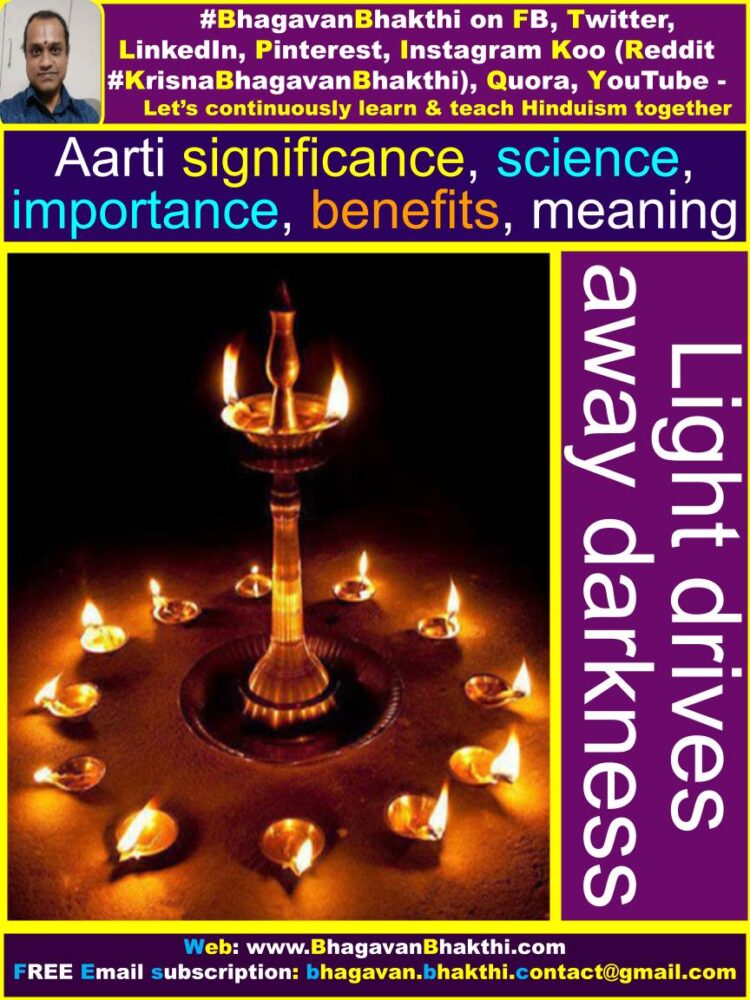
[Note : For example, before the Mahabharata (Kurukshetra) battle, the Pandavas performed aarti (pooja) of their weapons. They had seen Lord Sri Krishna inside those weapons as ‘Antaryami’ (God present inside). Even today in many parts of India people perform aarti (puja) of their tools during Dussehra (Dasara) on the day of Ayudha Puja.]
How and why to do aarti of a person (someone) (things) : In every living or non-living being, Lord Sri Vishnu (Krishna) is present as ‘Antaryami’ (present within) and thus we can perform the puja of all people. To be more precise, here we are worshiping (Aarti) Lord Sri Krishna (Vishnu) within that person (someone) or something or things.
One can take clean a plate, add some water in it and also add little bit of kumkum and haldi inside it and mix it properly. After that, you can keep a small deepa (diya) (lamp) in the middle of the plate. You can do the Aarti of the person or someone or something or things in the clockwise direction.
It is a common practice for Hindus to perform aarti on inanimate objects such as vehicles, electronics, etc., when they are newly purchased and before using it, as a sign of respect and to pray that the object will help them excel at work.
[Note : It should be noted that these objects or things are not God, but God who is ‘Antaryami’ (God within) within them is the true and only God. God is the one who sits inside and protects these things and ensures that those things or objects function properly.]

When Aarti is done of the person or things (objects) : Etymologically speaking, the word Aarti means “before darkness”. This refers to the fact that the first of the aartis of a person is done at home and that of objects or things is done in traditional temples before the end of the night, i.e.
early in the dawn. As the darkness of God’s forgetfulness envelops us again and again, Aarti is performed repeatedly to end the night of forgetfulness.
We perform Aarti or Puja of a person or objects or things because, everything we have belongs to God and Aarti is a method prescribed in Vedic scriptures like Pancharatras to humbly and gratefully acknowledge His divine ownership. God is the real own and we are just his followers.
When we observe Aarti prayerfully or reverently, our head is illuminated by the glory of God and our heart is exhilarated by the beauty of God. The objects given are transformed into carriers of divine mercy or prasadam.
And thus we can receive divine power by passing the deepa (diya) (lamp) with our hands over its flame and touching it to the forehead, by sprinkling our heads with holy water, by reverently smelling their fragrance from holy flowers.
So remember friends, the next time you are doing aarti (arti) of a person or things or objects, you should follow the above points and tune in to the divine vibrations and get God’s full blessings.

What is offered during Aarti : Symbolically, aarti refers to the offering of creation to the creator (Lord Sri Vishnu) represented by the various objects offered during the aarti (represented by the deity, the divine representation).
Let us consider the divine Srimad Bhagavad Gita 7.4 and 7.5 slokas (verses) as given below:
भूमिरापोऽनलो वायु: खं मनो बुद्धिरेव च | अहङ्कार इतीयं मे भिन्ना प्रकृतिरष्टधा || 7.4 ||
ಭೂಮಿರಾಪೋಯನಲೋ ವಾಯು: ಖಂ ಮನೋ ಬುದ್ಧಿರೇವ ಚ | ಅಹಂಕಾರ ಇತಿಯಂ ಮೇ ಭಿನ್ನಾ ಪ್ರಕೃತಿರಷ್ಟಧಾ || 7.4 ||
Bhūmirāpōyanalō vāyu: Khaṁ manō bud’dhirēva ca | ahaṅkāra itiyaṁ mē bhinnā prakr̥tiraṣṭadhā || 7.4 ||
Meaning of the sloka word by word : bhūmiḥ—earth; āpaḥ—water; analaḥ—fire; vāyuḥ—air; kham—space; manaḥ—mind; buddhiḥ—intellect; eva—certainly; cha—and; ahankāraḥ—ego; iti—thus; iyam—all these; me—my; bhinnā—divisions; prakṛitiḥ—material energy; aṣhṭadhā—eightfold
Meaning of the sloka : Earth (Bhumi), water, fire (agni), air (vayu), space, mind (manas), intellect and ego (ahankar) – these are the eight elements of my physical energy.
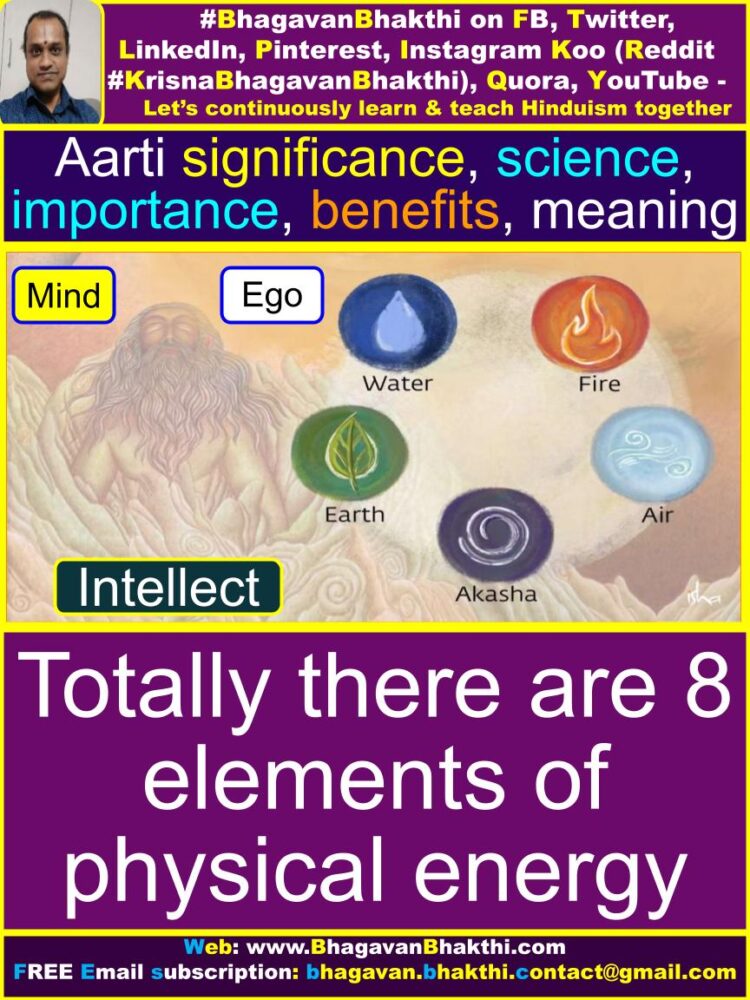
अपरेयमितस्त्वन्यां प्रकृतिं विद्धि मे पराम् | जीवभूतां महाबाहो ययेदं धार्यते जगत् || 4.5 ||
ಅಪರೇಯಮಿತಸ್ತ್ವನ್ಯಾಂ ಪ್ರಕೃತಿಂ ವಿದ್ಧಿ ಮೇ ಪರಮ್ | ಜೀವಭೂತಾಂ ಮಹಾಬಾಹೋ ಯಯೇದಂ ಧಾರ್ಯತೇ ಜಗತ್ || 4.5 ||
Aparēyamitastvan’yāṁ prakr̥tiṁ vid’dhi mē param | jīvabhūtāṁ mahābāhō yayēdaṁ dhāryatē jagat || 4.5 ||
Meaning of the sloka word by word : aparā—inferior; iyam—this; itaḥ—besides this; tu—but; anyām—another; prakṛitim—energy; viddhi—know; me—my; parām—superior; jīva-bhūtām—living beings; mahā-bāho—mighty-armed one; yayā—by whom; idam—this; dhāryate—the basis; jagat—the material world
Meaning of the sloka : That is my inferior energy. But beyond that, O mighty Arjuna, I have supreme power. It is Jiva Shakti (Atma / Soul Power), which consists of embodied souls who are the basis of life in this world.
In-depth meaning of the above two slokas (verses) : Srimad Bhagavad Gita (7.4 and 7.5) analyzes the material world as made up of eight elements as given here: earth (representing all solids), water (representing all liquids), fire (representing all radiations and energies), –
air (representing all gases), ether (substrate for cosmic existence and transmission of sound), mind (subtle division of emotions), intelligence (subtle faculty of rational thought) and false ego (the invisible bond that causes the soul to be mistakenly identified with the body).
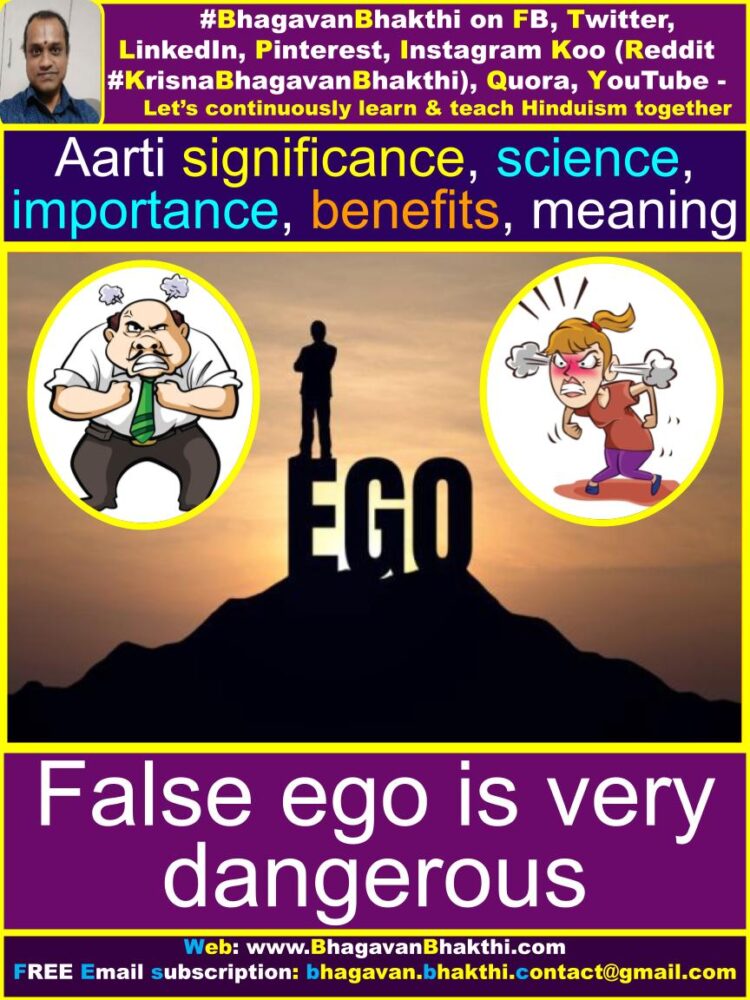
During the aarti, the various objects offered to the deity represent these elements: flower and cloth represent earth, water represents elemental water, ghee lamp represents fire, yak-tail fan represents air, sound of conch and –
bell represents ether, songs sung and chanted mantras represent mind, the intellectual focus on the purpose of the aarti represents wisdom (intelligence), the bows represent ego (pride) and the pujari represents the assembled worshippers.
So during marriage or sacred thread ceremony (Yagnopaveetham / Janeu), after applying turmeric to the bride or the groom, they are protected from evil by auspicious waving of lamps (doing Aarti). Similarly on Bhai Dooj or Bhai Beej Day, Diwali, New Year, or when heroes return home, deepas (diyas) (lamps) are waved to protect them from the evil eye.
There is also a belief that ghosts and evil spirits and animals are afraid of the brightness of the fire. The light produced by fire is considered miraculous and is a unique concept of all cultures and Dharma across India.
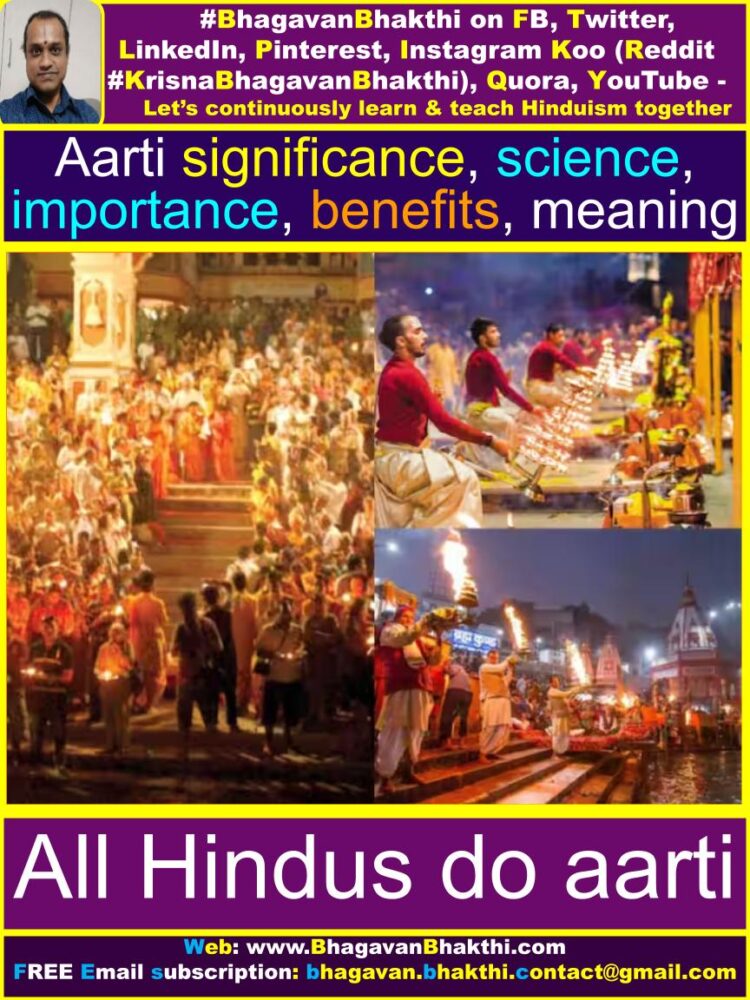
Sri Ramana Maharishi has said that : Camphor Aarti symbolizes the burning of the mind with light, vibhuti (holy ashes) for Shiva (the absolute being), and kumkum (vermilion powder) for Shakti (consciousness).
Vibhuti (विभूति) (sacred ash) is of two kinds: Para Vibhuti (पर विभूति) and Apara Vibhuti (अपर विभूति). Vibhuti or holy ashes belong to the latter category. What remains after when everything has been burnt by the fire is the ‘Fire of Realization’, i.e. that is Supreme Personality or Parama Purusha (Vishnu).
In Aarti, Jyoti or deepa or lamp (diya) means soul (atma). Usually the five Jyotis or deepas or diyas or lamps represent the five pranas (प्राण) (prāṇa). The plate or deepa or diya or lamp holder represents the body.
So, basically when we wave the lighted lamp in front of the deity we are saying to the Lord give us the blessings and I will do all the prescribed works as per Dharma. Based on this thought we have ‘Deva Podhi Ekadashi’ and ‘Deva Uti Ekadashi’. The period between these two Ekadashis is a period of rest (Yoga Nidra) for the Lord Vishnu.

Benefits of doing Aarti (Arti) is as given below:
1. Worship in a congregational setting is helpful in more ways than one. It increases the devotion towards God and also gives self confidence. Along with this all the real and true devotees can unlimited blessings from God, both mundane and spiritual.
2. In a group prayer all the devotees can pray in a space charged with the fervor of a group’s uniform devotion, cutting across the inhibitions of ego and merging easily into the group rhythm.
3. Doing group Aarti induces a sense of expanded consciousness in which one tends to subtly lose the individual ‘voice’, the awareness that is part of the ‘whole’ consciousness of individual identity dissolves into the mainstream of collective consciousness.
4. Performing Aarti daily removes the obstacles of life and shows the path to devotees as they are directly connected with God, who leads them on the path of worldly and spiritual success.
5. Performing Aarti enhances the devotion and spirituality of the devotee and he or she becomes closer to God. Adhyatma (Spirituality) strengthens the devotees spiritually, emotionally, dharmically, mentally and physically. Thus Aarti is also beneficial for good health.
6. Agni or Fire is one of the basic elements of Aarti (Pancha Bhuta) known for its purifying aspect. It creates a purified and divine aura around the deity being worshipped. Thus aarti creates a positive and purified environment around God and it purifies mind and thoughts.
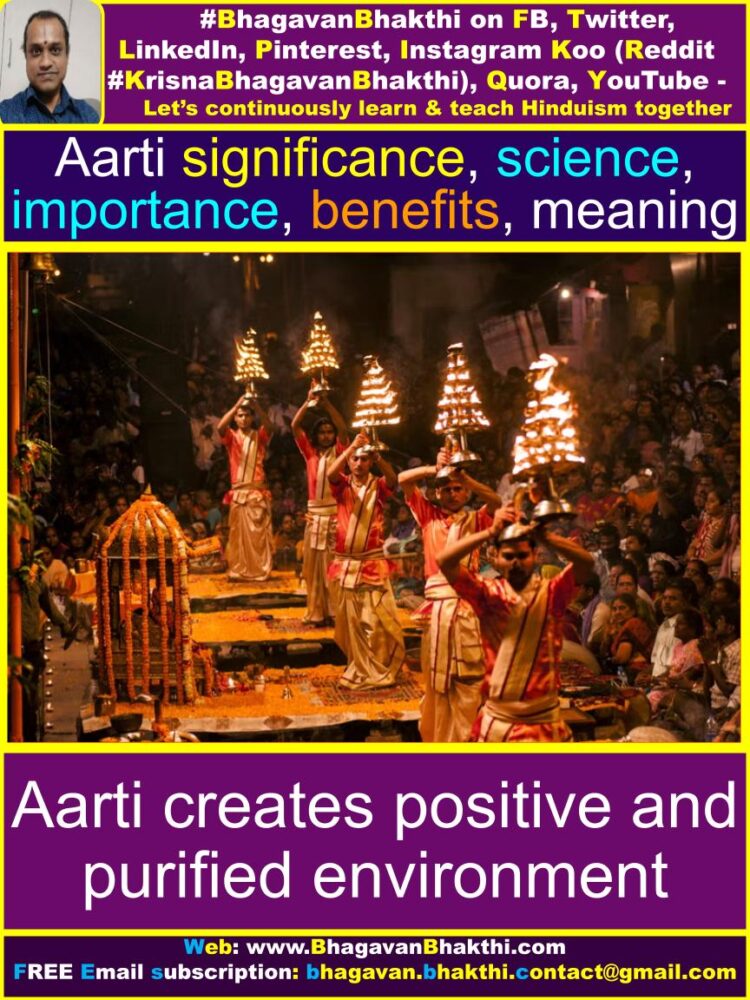
The philosophy behind Aarti : The ritual of doing or performing Aarti with the light flame dispels darkness from our heart and home, the burnt incense gives divine fragrance, the bell (ghanta) dispels negative energy and claps during the aarti provides that extra energy to us.
If you ask a feng-shui expert, that person will confirm that all of the above are very good for warding off the evil eye! When the five-wick lamp is lit, the devotee symbolically waves it, offering his five pranas to the God. [The whole being of the five pranas, i.e. Prana (प्राण), Apana (अपान), Samana (समान), Udana (उदान) and Vyana (व्यान).]
Prana has its seat in the lungs and is breath, while Apana goes downwards and out at the anus. Samana has its seat in the umbilical cavity and is essential for digestion. Udana rises in the throat and enters the head and Vyana is diffused through the whole body.
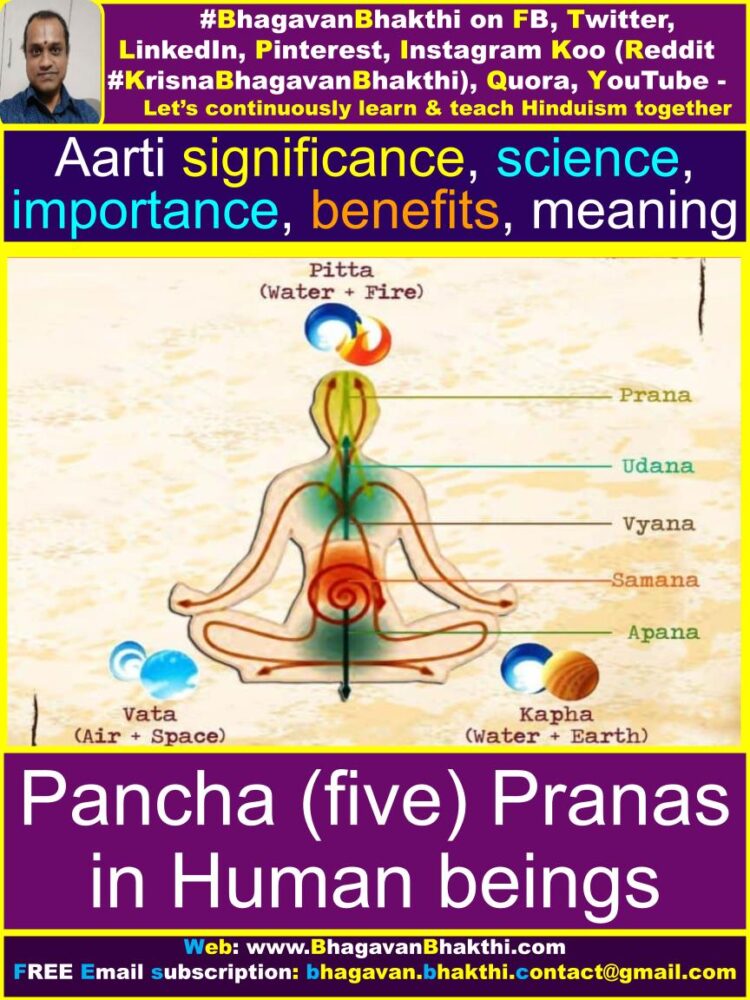
Why do we perform aarti to God – At the end of every ritualistic worship (pooja or bhajan) of the Lord or to welcome an honored guest or saint or Guru, we perform aarati. It is always accompanied by doing ghanta (bell) sound and sometimes singing, playing musical instruments and clapping.
This is one of the sixteen steps (Shodasha Upacharas) (षोडश उपचार) of the Puja Ritual. It is known as auspicious light (Mangal Neeraajanam) (मङ्गल नीराजनं). Holding the lighted lamp in the right hand, we wave the flame (agni / fire) in a clockwise circular motion to illuminate the entire form of the God.
Each part is revealed separately and similarly the complete form of the God. When the light is waved we chant prayers mentally and / or aloud or simply look at the beautiful form of the God illuminated by the deepas or diyas or lamps.
Devotees experience great intensity in their prayers and the special beauty of the God is visible at that time. At the end of the aarati we place our hands on the flame and then gently touch our eyes and top of the head (taking aarti or mangal aarti).
Most of us have seen and participated in this ritual of Aarti since our childhood. Worship the God with love and devotion, performing Abhishekam, decorate the deity with ornaments, tulasi, flowers etc., and offer fruits and delicacies, we see the beauty of the God in all His glory (alankaram).
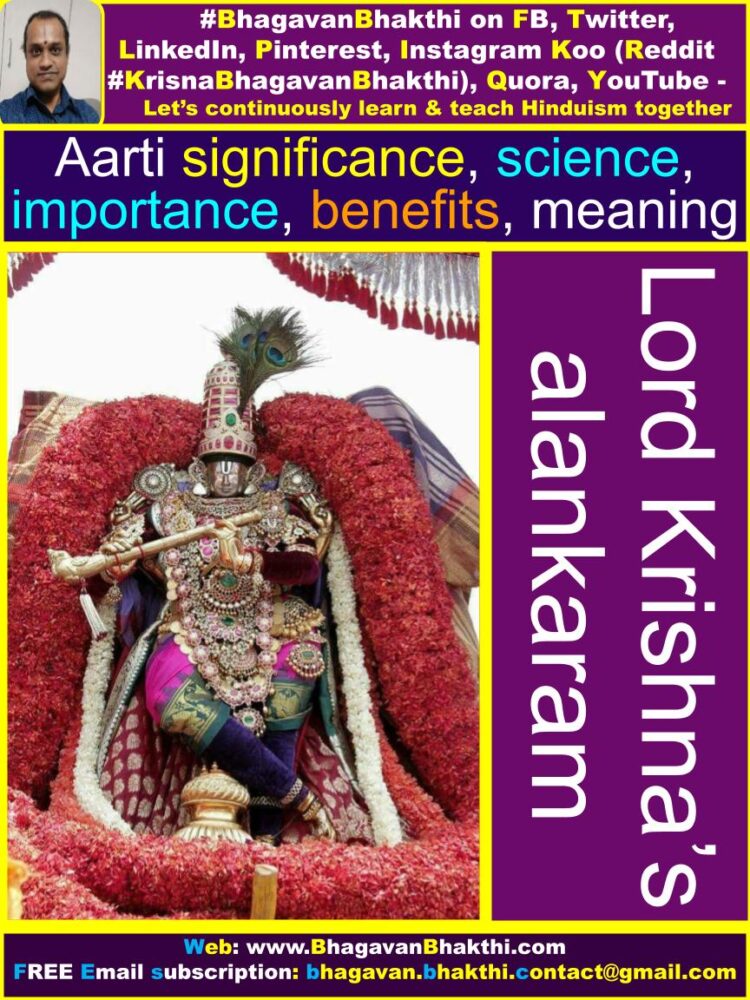
While lit by the lamp our mind is focused on each and every limb of the God. It is akin to silent open-eyed meditation on His beauty. Singing, clapping, ringing of bells etc. indicate joy and auspiciousness with the Lord’s darshan.
Aarti is often done with camphor (कर्पूर). It has a telling spiritual significance. When camphor is lit it burns completely without leaving a trace. Camphor represents our innate instincts (vaasanas / वासना).
When lit by the fire of knowledge that illuminates the Lord (Truth), our vasanas (वासना) then burn themselves out completely, leaving no trace of the ego that creates a sense of separation in us and makes us to fall in love with God.
Also when camphor is burnt to convey the glory of the God, it emits a pleasant fragrance even during sacrifice. In our spiritual progress, even as we serve Guru and society, we must willingly sacrifice everything we have and everything we have to spread the “fragrance” of love to all.
We usually wait for a long time to see the illuminated God but when the aarti is actually done, our eyes automatically close to look within. We hold the divinity to indicate that each of us is a temple of God.
Just as the priest reveals the form of the Lord with the arati flame, the Guru clearly reveals to us the divinity within each of us with the help of the “flame” (or light of spiritual knowledge) of knowledge.
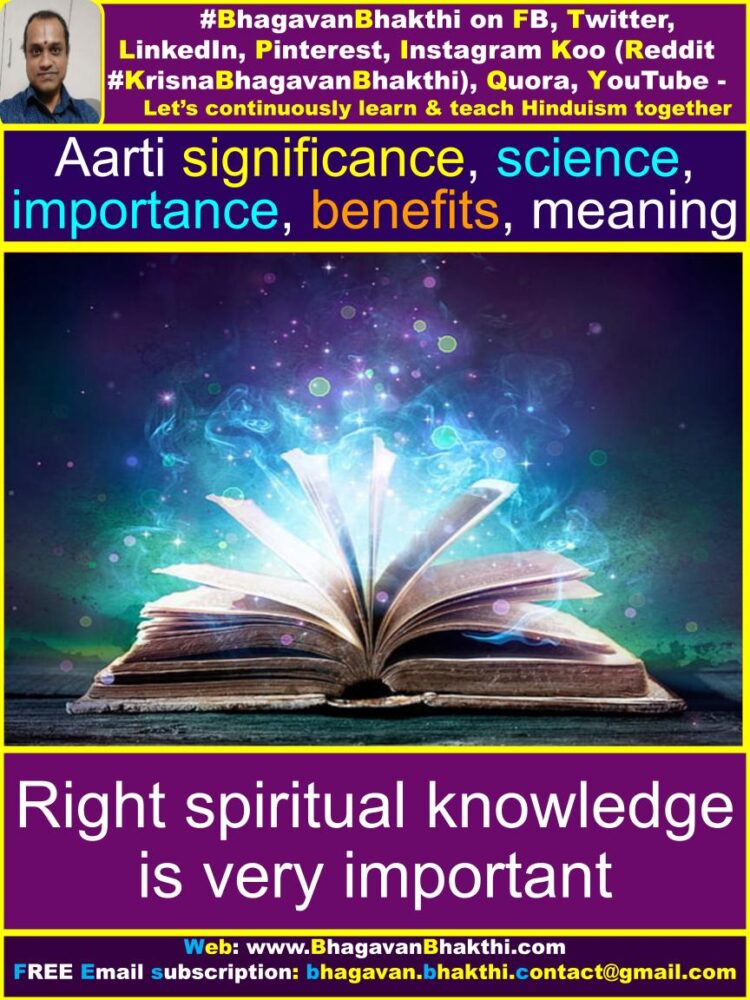
After aarti, we place our hands on the flame and then touch our eyes and top of the head. It means – let the light that enlightened the Lord illuminate my vision, mind and soul. May the vision be divine and my thoughts noble and beautiful forever.
The philosophical meaning of aarti extends further. Sun, moon, stars, lightning and fire are natural sources of light. Lord is the source of all these wonderful phenomena of the universe. It is only by Him that all else exists and shines.
As we illuminate the Lord with the flame of Aarti, we turn our attention to the source of light that symbolizes knowledge and life. Similarly, Lord Surya (The Sun God) is the presiding deity of intellect; Lord Chandra, that of the mind; And Lord Agni of the speech.
The Lord is the Supreme Consciousness that illuminates them all. Without Him the intellect cannot think, neither the mind can feel nor the tongue can speak. God is beyond mind, intellect and words. How can these finite means illuminate the infinite Lord?
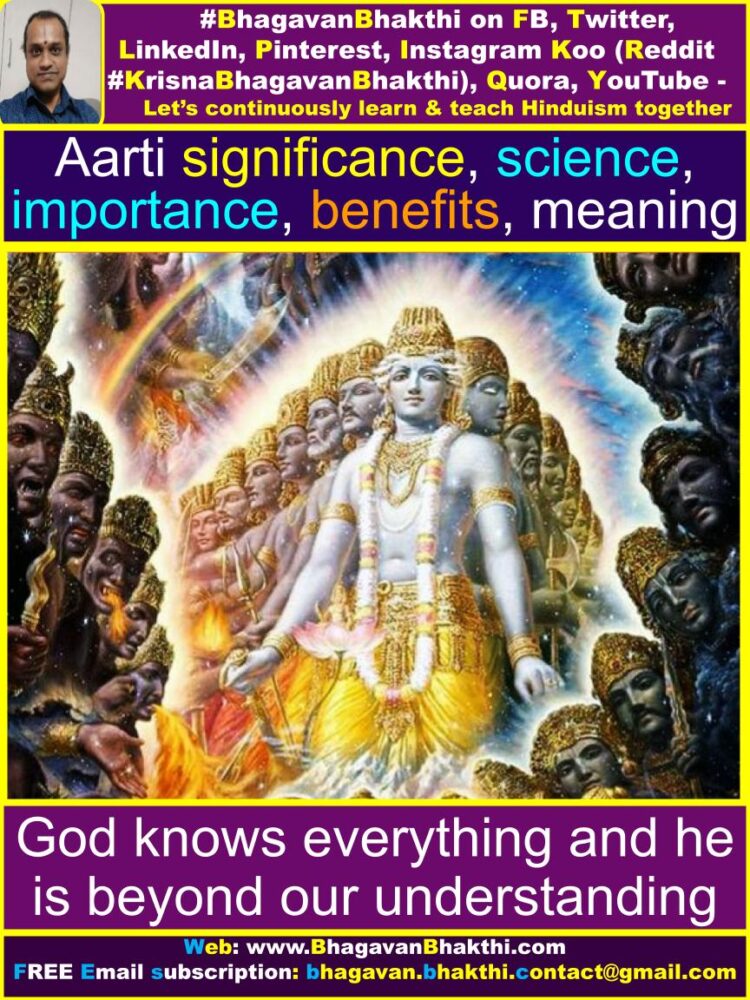
So when we do aarti we should chant the following mantra: This mantra is taken from ‘Katha Upanishad’ 2.2.15 :
न तत्र सूर्यो भाति न चन्द्र तारकं नेमा विद्युतो भान्ति कुतोऽयमग्निः । तमेव भान्तमनुभाति सर्वं तस्य भासा सर्वमिदं विभाति ॥
ನ ತತ್ರ ಸೂರ್ಯೋ ಭಾತಿ ನ ಚಂದ್ರ ತಾರಕಂ ನೇಮ ವಿದ್ಯುತೋ ಭಾಂತಿ ಕುತೋऽಯಮಗ್ನಿಃ । ತಮೇವ ಭಾಂತಮನುಭಾತಿ ಸರ್ವಂ ತಸ್ಯ ಭಾಸಾ ಸರ್ವಮಿದಂ ವಿಭಾತಿ ||
Na tatra sūryō bhāti na candra tārakaṁ nēma vidyutō bhānti kutō̕yamagniḥ। tamēva bhāntamanubhāti sarvaṁ tasya bhāsā sarvamidaṁ vibhāti ||
Meaning of the sloka : He (Lord Shri Vishnu) is there where the sun does not shine, where there is no moon, stars and lightning. So what to talk about this small flame (in my hand) ! Everything (in the universe) shines only because of Lord Sri Vishnu and by His light we all shine.
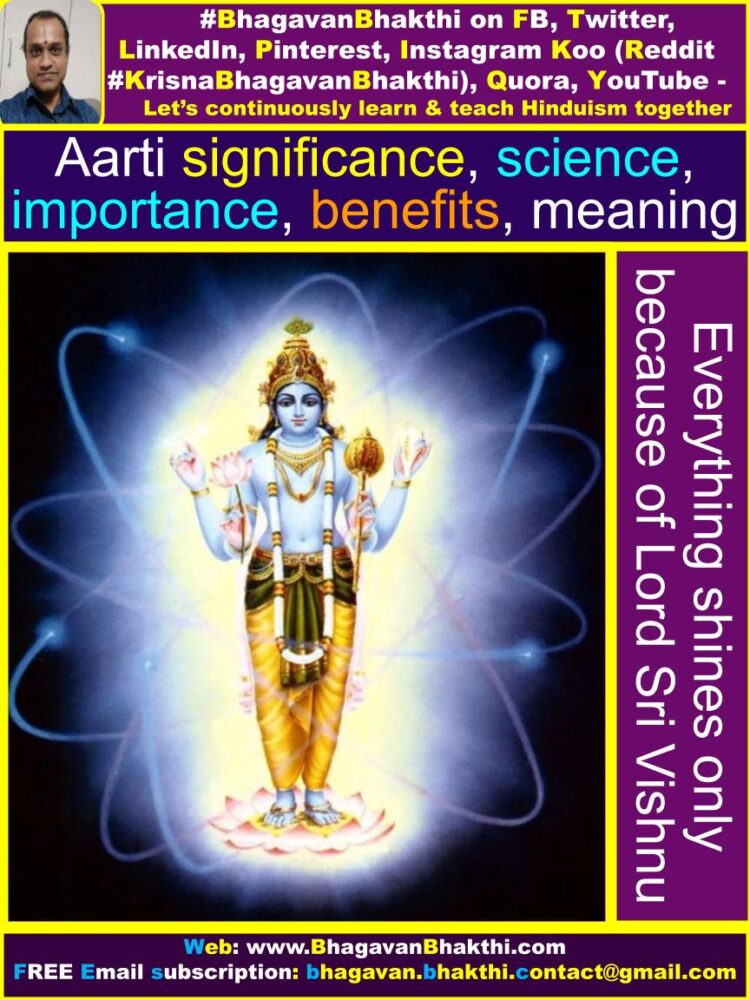
Continue reading about Hindu Samskaras (Sanskars) – Hindu Samskaras (Sanskars) information, significance, importance.
More information will be added to this on regular basis, please visit after some time to know more information.
To watch videos on #Hinduism #Sanskrit language, SUBSCRIBE to my YouTube channel from this below link:
#BhagavanBhakthi YouTube channel
Dear friends, if you need any clarifications about this post, kindly let me know, I will definitely try to answer all of them.
Also your one LIKE, one COMMENT, One Share, one SUBSCRIPTION is highly important.
This will help to know the quality of this content and also it will be helpful to know if any improvements is required for the content.
If you feel this content is useful to you and has helped you to improve your knowledge, kindly share this with your well-wishers.
Because “SHARING MEANS CARING”.
To receive FREE EMAIL SUBSCRIPTION about #BhagavanBhakthi, you can send an email to [email protected] from your email ID.
NAMASTE!
Sri Gurubhyo Namaha
Sri Krishnaaya Namaha
Sri Krishnaarpanamastu
Subscribe / Follow us Share in Social Media